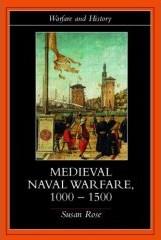Medieval and Renaissance naval battles, castles of the Teutonic Knights, wooden medieval structures in north Russia
Medieval naval operations were almost invariably in support of land operations. They were operations to maintain naval supremacy with exceptions being possibly the operations of the Venetian state and the Hanseatic League. Battles would often be within sight of land and battles in the high seas were practically unknown. What is interesting is that these naval battles resembled land battles except that the battlefields were platforms on the ships of that period. Ships would often be tied together and boarding actions would commence. Forecastles were similar to fortifications on land with archers providing fire support on top.
The naval battles in the Mediterranean Sea were of course of a different nature due to the use of galleys. Logistical issues were of course another matter with galleys.
 I have been reading up on medieval and renaissance naval battles for the last year. It is fascinating. Susan Rose's 'Medieval Naval Warfare'
I have been reading up on medieval and renaissance naval battles for the last year. It is fascinating. Susan Rose's 'Medieval Naval Warfare'I have bought a volume on the Battle of Lepanto. Victor Hanson, the doyen of Greek hoplite warfare, had also written a chapter on this battle in one of his popular history volumes. The arguments regarding the dearth of naval specialists in the Islamic world after Lepanto appear well-founded. I would have to read more on this before I can formulate my thoughts on this.
Previously, I had read two books on the siege of Malta in 1565, one of which is an Osprey book which was heavily illustrated with colourful maps of the operations. The other book is a straight forward narrative.

John Francis Guilmartin's classic 'Gunpowder & Galleys' has now been re-published as a second edition. There are few changes to this classic work.
There is a lot of hard data and information in this volume. Highly recommended.
I have been fascinated by the architecture of the castle of the Teutonic Knights at Marienburg. The squat towers, the narow windows, the arrow slits, the forbidding walls. A nightmarish structure which could have come out of the pages of a dark fairy tale.
The medieval wooden churches and houses of Russia are also of interest due to its intricate design and flourishes. There are several illustrated tomes of these structures available. I can only say that I am astounded as to what can be accomplished with wood! Speaking of which, there are wooden temples in Japan that are almost a thousand years old.
"After the dream, they set out in search of that city; they never found it, but they found one another; they decided to build a city like the one in the dream."
Exerpt from Italo Calvino's 'Invisible Cities'
No comments:
Post a Comment